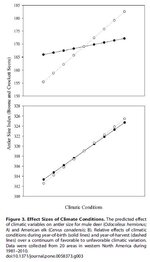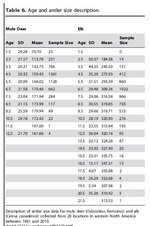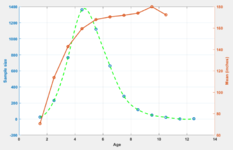CM
WKR
Some of you have probably already read this paper (it was published in 2013), but I found it interesting.

 journals.plos.org
journals.plos.org
The paper studies the long lasting effects of mother's health in antler size of mule deer and elk. Obviously, all herds are different but this study looked at several different herds in Montana, Idaho, Wyoming, Colorado, Utah, and New Mexico. For those of you not wanting to read the whole paper, here's an excerpt of their findings:
For Deer:
"Late-winter temperature (year-of birth) was positively correlated with antler size, while early-winter precipitation (year-of-birth) was negatively correlated with antler size. Both of these variables indicate that mild winters prior to an individual’s birth positively influenced the antler size of that individual throughout its lifetime in our sample. The effect size associated with these two variables on antler size of mule deer was 8% from the most to least favorable climate conditions observed in our data set (Figure 3). However, the majority of individuals were born during more average years, and effect size was estimated at 4% across this continuum (cumulative monthly z score from -4 to 4). Climate conditions during the harvest year had a stronger influence as we estimated a 28% change in average antler size from the most to least favorable years observed and 18% across the range of values most commonly observed."
For Elk:
"Our analysis indicated that increased summer (April – July) temperature during the year-of-birth was associated with greater antler size later in life. Additionally, increased snowfall during the year-of-birth was correlated with increased antler size throughout life. The effect size of maternal condition on antler size of American elk was 7.4% from the most to least favorable climate conditions that females experienced during the year of-birth (Figure 3). However, the majority of individuals were born during more average years, and the effect size was 3.7% across this continuum (cumulative z score from 24 to 4). Effect size of climate conditions during the harvest year on the antler size of American elk was similar (8.4% across full range of observed conditions; 4.2% across commonly observed values) to that found during the birth year."
Here's their graphs showing the data. I think the most interesting finding is the volatility of deer antler size based on the climate during year of harvest (top graph, dotted line).

Here's another table from the paper. I was surprised that the 9.5 year old bucks were still averaging 180". I always thought they were on the decline by then. I also thought the fact that on average a mature buck is ~170" was interesting, I always assumed that but never really had any evidence to back it up.

Long-Lasting Effects of Maternal Condition in Free-Ranging Cervids
Causes of phenotypic variation are fundamental to evolutionary ecology because they influence the traits acted upon by natural selection. One such cause of phenotypic variation is a maternal effect, which is the influence of the environment experienced by a female (and her corresponding...
The paper studies the long lasting effects of mother's health in antler size of mule deer and elk. Obviously, all herds are different but this study looked at several different herds in Montana, Idaho, Wyoming, Colorado, Utah, and New Mexico. For those of you not wanting to read the whole paper, here's an excerpt of their findings:
For Deer:
"Late-winter temperature (year-of birth) was positively correlated with antler size, while early-winter precipitation (year-of-birth) was negatively correlated with antler size. Both of these variables indicate that mild winters prior to an individual’s birth positively influenced the antler size of that individual throughout its lifetime in our sample. The effect size associated with these two variables on antler size of mule deer was 8% from the most to least favorable climate conditions observed in our data set (Figure 3). However, the majority of individuals were born during more average years, and effect size was estimated at 4% across this continuum (cumulative monthly z score from -4 to 4). Climate conditions during the harvest year had a stronger influence as we estimated a 28% change in average antler size from the most to least favorable years observed and 18% across the range of values most commonly observed."
For Elk:
"Our analysis indicated that increased summer (April – July) temperature during the year-of-birth was associated with greater antler size later in life. Additionally, increased snowfall during the year-of-birth was correlated with increased antler size throughout life. The effect size of maternal condition on antler size of American elk was 7.4% from the most to least favorable climate conditions that females experienced during the year of-birth (Figure 3). However, the majority of individuals were born during more average years, and the effect size was 3.7% across this continuum (cumulative z score from 24 to 4). Effect size of climate conditions during the harvest year on the antler size of American elk was similar (8.4% across full range of observed conditions; 4.2% across commonly observed values) to that found during the birth year."
Here's their graphs showing the data. I think the most interesting finding is the volatility of deer antler size based on the climate during year of harvest (top graph, dotted line).

Here's another table from the paper. I was surprised that the 9.5 year old bucks were still averaging 180". I always thought they were on the decline by then. I also thought the fact that on average a mature buck is ~170" was interesting, I always assumed that but never really had any evidence to back it up.



